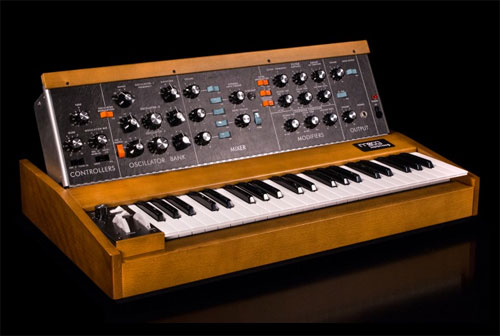Moog Music announced today that after more than 30 years, production of the Minimoog Model D synthesizer has resumed. The Minimoog Model D was the first portable synthesizer and served as the standard for all electronic keyboards that followed.
Conceived as a response to the large-scale modular synthesizers of the 1960s, the Minimoog’s portability, accessibility, and expressiveness made it the go-to instrument for musicians looking to expand beyond the traditional sounds of the time.
The Minimoog Model D has been used by music innovators to give shape to the sounds of the future. Progressive rock and fusion luminaries like the late Keith Emerson (ELP), Rick Wakeman (Yes), Chick Corea (Return to Forever), Jan Hammer (Mahavishnu Orchestra), Jürgen Fritz (Triumvirat) and Peter Bardens (Camel) led the way. Later, Bernie Worrell used the Minimoog to develop Parliament Funkadelic’s futuristic funk sound.
German band Kraftwerk used the Minimoog on the pioneering concept electronic music album Autobahn. Gary Numan replaced his live band’s guitars with Minimoogs. The classic sound of the Minimoog Model D can be heard on Bob Marley’s “Catch A Fire” and Michael Jackson’s “Thriller.”
Each Minimoog Model D is handcrafted at the employee-owned Moog factory in Asheville, North Carolina. This legendary 3-oscillator monophonic instrument is securely housed in a hand-finished aluminum chassis and locally-sourced Appalachian hard-wood enclosure. To realize the unmistakable sound of the world’s first performance synthesizer, Moog preserves the component placement and through-hole design of the original analog circuit boards, employs military-spec precision resistors and custom-reissued transistors to complete the circuit.
Even though no changes have been made to the original sound engine or audio signal path, the Minimoog Model D now includes a series of functional modifications to expand the instrument’s sonic capabilities beyond the factory specifications of a 1970’s production unit. These modifications include a premium Fatar keybed with velocity and after pressure available via top panel CV jacks, a dedicated analog LFO with triangle and square waveshapes, CV outputs for pitch, gate, velocity and after pressure, basic MIDI integration, and a mixer overload modification, which when engaged, allows the Minimoog Model D to conjure thicker and far more overdriven sounds than before.
Due to the complexity of the build process coupled with the demand for other Moog instruments, Moog Music is only able to produce a small number of Minimoog Model D units per month.
Watch a Brief History Of The Minimoog:
More about Moog Music: www.moogmusic.com

